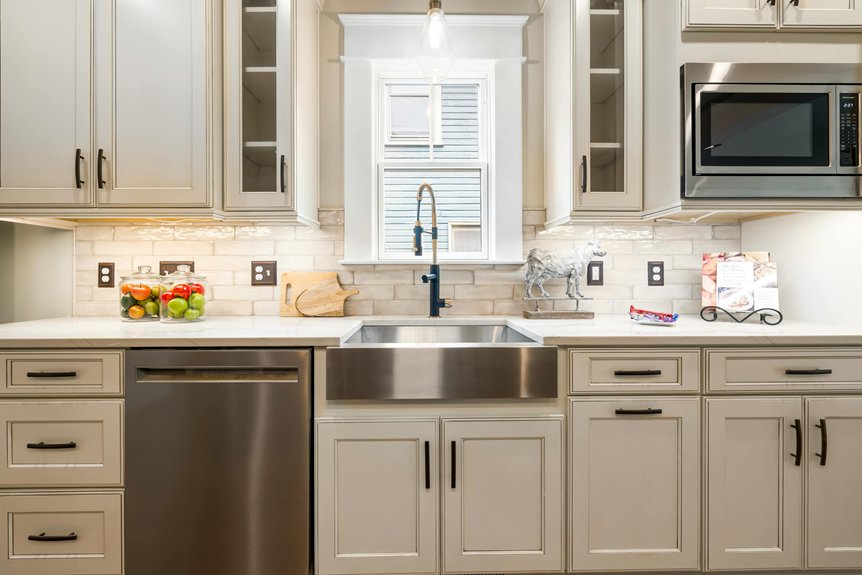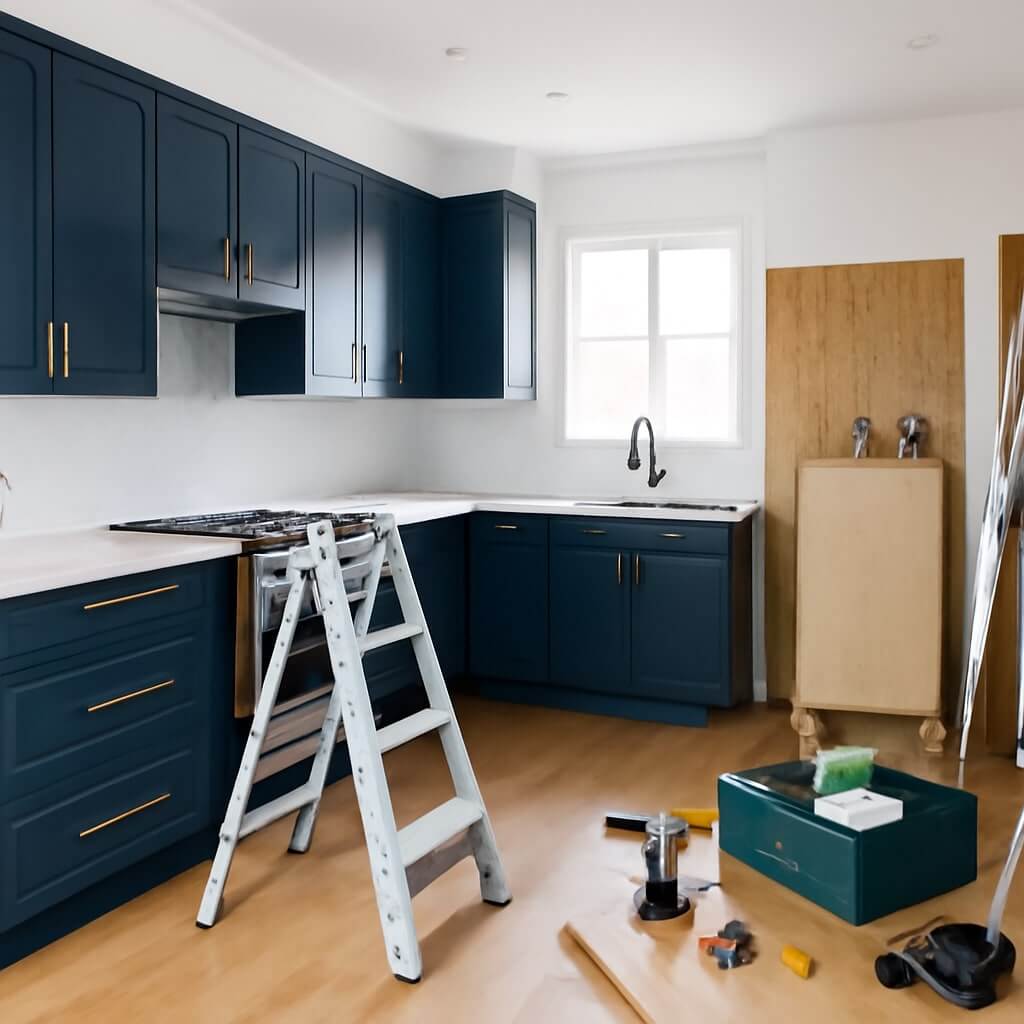When you’re remodeling your kitchen, setting up a temporary cooking space can seem challenging. But with the right approach, you can make it work seamlessly. Start by designating a cooking zone that’s close to power and water sources. Next, reflect on how to organize your essential tools for easy access. These foundational steps will set you on the right path, but there’s more to think about for a truly efficient setup. Let’s explore those essential tips.
Key Takeaways
- Designate a cooking zone close to power and water for efficient meal prep and organization.
- Organize essential tools and equipment into designated storage zones, ensuring frequently used items are easily accessible.
- Stock up on non-perishable ingredients like rice and canned goods, and organize them for quick meal planning.
- Utilize compact small appliances, such as a slow cooker or toaster oven, for versatile cooking in limited space.
- Maintain cleanliness with a daily cleaning routine, including surface wipes and trash disposal, to ensure a safe cooking environment.
Designate a Cooking Zone
When setting up your temporary kitchen, the first step is to designate a cooking zone that’s both functional and efficient.
Choose a space that’s easily accessible, ideally near a power source and water supply. A small table or countertop can serve as your primary work area, ensuring you maximize cooking efficiency.
Designate a convenient cooking space close to power and water to enhance your kitchen efficiency.
Arrange your cooking essentials—like pots, pans, and utensils—within arm’s reach to streamline meal prep.
Don’t forget to contemplate space optimization; utilize vertical storage for ingredients and appliances.
This thoughtful setup will help you whip up meals smoothly while minimizing chaos in your temporary kitchen environment.
Organize Essential Tools and Equipment
When setting up your temp kitchen, it’s essential to prioritize the tools you use most often, ensuring they’re within easy reach.
Create designated storage zones for different categories of equipment, and don’t forget to label everything clearly so you can find what you need without wasting time.
This organized approach not only streamlines your cooking process but also makes cleanup a breeze.
Prioritize Frequently Used Items
To make your temporary kitchen setup functional and efficient, start by prioritizing the items you use most often.
Identify your frequently used item categories, such as cooking utensils, pots, pans, and dishes. Gather these essentials and keep them within easy reach, perhaps in a designated drawer or countertop space.
For items like knives, measuring cups, and spatulas, consider using a caddy or magnetic strip to stay organized. This way, you won’t waste time hunting for tools while preparing meals.
Designate Storage Zones
After gathering your frequently used items, the next step is to designate storage zones that keep your kitchen organized and functional.
Consider convenient storage solutions that maximize space optimization. Group similar tools together—place cooking utensils near the stove, and store pots and pans in a cabinet close by.
Reserve a section for small appliances you use daily, ensuring easy access. Use baskets or bins to contain smaller items, preventing clutter.
By thoughtfully arranging your essentials, you’ll create a streamlined workflow, making meal prep smoother and more enjoyable.
An organized temp kitchen will make the remodel feel less chaotic and more manageable.
Label Everything Clearly
A well-organized kitchen thrives on clarity, and labeling everything clearly is a game-changer.
Use simple labeling techniques, like color coding or bold fonts, to create eye-catching and clear signage for your essential tools and equipment.
Whether it’s pots, utensils, or pantry items, knowing where everything is saves you time and reduces stress.
Stick labels on shelves or containers, ensuring they’re easy to read at a glance.
This way, you won’t waste precious moments hunting for what you need.
Remember, a little effort in labeling goes a long way in maintaining order during your remodel.
Keep it organized and efficient!
Stock Up on Non-Perishable Ingredients
When setting up your temporary kitchen, stocking up on non-perishable ingredients is a game-changer.
Think of essential pantry staples like rice, beans, and canned tomatoes that can form the backbone of countless meals.
With a well-stocked pantry, you’ll not only save time but also release your creativity for delicious meal prep ideas.
Essential Pantry Staples
As you commence your temporary kitchen adventure, stocking up on essential pantry staples will set you up for success and make meal prep a breeze.
Think about organizing your pantry efficiently; grab non-perishable essentials like pasta, rice, canned beans, and tomatoes.
Don’t forget spices and herbs—they’ll elevate your meals without fuss. Consider including oils and vinegars for added flavor.
Keep your pantry organization simple by categorizing items, making it easy to find what you need.
With these essential ingredients on hand, you’ll navigate your temporary kitchen like a pro, ensuring every meal is satisfying and stress-free.
Meal Prep Ideas
To make the most of your temporary kitchen setup, consider meal prep ideas that focus on non-perishable ingredients. Stock up on essentials like canned beans, pasta, and rice for versatile meals.
Batch cooking is a game changer—prepare large quantities of chili or quinoa salad, then divide the portions into meal prep containers for easy grab-and-go options throughout the week.
Don’t forget spices and sauces; they’ll elevate your dishes without taking up much space.
With a little planning, you’ll enjoy delicious, stress-free meals even in a temporary kitchen, keeping your energy up during the remodel.
Happy cooking!
Utilize Small Appliances Wisely
Although you might feel limited in a temporary kitchen, small appliances can transform your cooking experience into something efficient and enjoyable.
Focus on smart small appliance selection to maximize functionality. A compact slow cooker or an instant pot can save space while offering versatility for various meals.
Don’t forget about a toaster oven; it’s perfect for quick snacks and reheating leftovers.
Prioritize efficient power usage by choosing energy-saving models, which can help minimize electricity costs during your remodel.
By utilizing these small appliances wisely, you’ll keep your culinary creativity alive, even in a limited space.
Happy cooking!
Create a Temporary Storage Solution
When you’re maneuvering a temporary kitchen, creating a practical storage solution can make all the difference in keeping your space organized and functional.
Start by installing temporary shelving wherever possible; it maximizes vertical space and keeps essentials within reach. Use creative containers—like colorful bins or stackable boxes—to sort utensils, spices, and ingredients.
Label everything so you can quickly find what you need. Don’t forget to repurpose items, such as dish racks for holding pots or baskets for storing snacks.
With these strategies, you’ll guarantee a clutter-free environment that makes cooking during your remodel a breeze.
Plan Simple, Quick Meals
Planning simple, quick meals is essential for managing a temporary kitchen without overwhelming yourself. Focus on meal planning that requires minimal cooking and cleanup.
Think one-pot dishes, salads, or stir-fries that can be whipped up in no time. When grocery shopping, stick to fresh produce, pre-cooked proteins, and pantry staples that can be easily combined.
Embrace quick meals with one-pot dishes, fresh salads, and stir-fries for effortless cooking and minimal cleanup.
Create a weekly menu to streamline your grocery list and avoid last-minute scrambles. With a little foresight, you can enjoy nutritious meals without the stress.
Embrace simplicity, and you’ll navigate your remodel with ease while still savoring delicious food.
Maintain Cleanliness and Safety
To keep your temporary kitchen safe and tidy, it’s essential to establish a routine that prioritizes cleanliness. A well-structured cleaning schedule helps you stay organized, while following safety protocols guarantees your space remains hazard-free. Here’s a quick reference table to help you:
| Task | Frequency | Notes |
|---|---|---|
| Wipe surfaces | Daily | Use disinfectant wipes |
| Sweep/Vacuum | Every other day | Prevents dirt buildup |
| Empty trash bins | Daily | Avoid unpleasant odors |
| Check equipment | Weekly | Guarantee everything’s safe |
Conclusion
By following these seven tips, you can turn your temporary kitchen into a well-organized space that makes cooking during your remodel a breeze. With a designated cooking zone, easy access to tools, and a focus on simple meals, you’ll find joy in the culinary process rather than stress. Embrace creativity with your small appliances and maintain cleanliness for a pleasant cooking environment. Remember, a little planning goes a long way in keeping your meals delicious and your spirits high!




